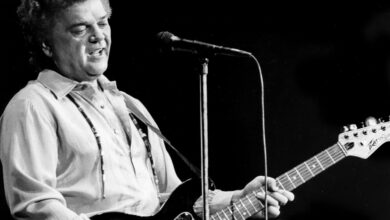The Everly Brothers’ “Crying in the Rain” – A 1962 Ballad of Heartache and Resilience
In 1962, Crying in the Rain by The Everly Brothers became one of the most poignant heartbreak songs of its era, blending melancholy with resilience in a way that resonated deeply with listeners. Released at a time when the duo was already well-established, the song showcased their signature harmonies while embracing a more dramatic and orchestral production than their earlier hits. Written by the legendary songwriting duo of Carole King and Howard Greenfield, Crying in the Rain climbed to No. 6 on the Billboard Hot 100, securing its place as one of the Everly Brothers’ most memorable ballads.
The Everly Brothers, Don and Phil Everly, were pioneers of rock and country fusion, shaping the sound of the late 1950s and early 1960s with their impeccable vocal harmonies and innovative guitar work. Raised in a musical family in Kentucky, the duo grew up immersed in country and folk traditions before finding national fame with a string of hits in the late 1950s, including Bye Bye Love, Wake Up Little Susie, and All I Have to Do Is Dream. Their smooth, close-knit harmonies set them apart from other rock acts of the time, making them a major influence on artists like The Beatles, Simon & Garfunkel, and The Beach Boys.
The creation of Crying in the Rain was a unique collaboration between two songwriting legends. At the time, Carole King and Howard Greenfield were working out of New York’s famed Brill Building, but they had never written together before. Greenfield, best known for his work with Neil Sedaka, typically partnered with Jack Keller, while King usually wrote with her then-husband Gerry Goffin. For this song, however, the two were paired together as part of a fun experiment by their publisher, and the result was a deeply evocative ballad about heartbreak, longing, and emotional restraint.
The song’s arrangement was crafted to enhance its sorrowful theme. Opening with a dramatic piano riff, Crying in the Rain builds gradually, with a subtle rhythm section and sweeping orchestration supporting the brothers’ haunting harmonies. Unlike the rockabilly-infused energy of their earlier hits, this song leaned into a more mature, dramatic style, highlighting the vulnerability in the lyrics. The Everly Brothers’ delicate yet powerful vocal delivery made the pain of lost love feel deeply personal, while the poetic imagery of using the rain to hide tears gave the song a timeless quality.
Upon its release, Crying in the Rain quickly climbed the charts, reaching No. 6 on the Billboard Hot 100 and becoming a top-ten hit in several other countries. While it didn’t achieve the same blockbuster success as some of their earlier songs, it was widely regarded as one of their most emotionally powerful recordings. The song’s restrained sadness and universal theme of heartbreak made it an instant favorite among fans, and it continued to receive steady airplay for years after its initial release.
Beyond its commercial success, the song had a lasting cultural impact. It marked a transition for The Everly Brothers as they moved away from their youthful rockabilly sound and embraced a more sophisticated, orchestral style. This shift reflected the broader evolution of pop music in the early 1960s, as artists began exploring more nuanced themes and arrangements in their work.
For Don and Phil Everly, Crying in the Rain was both a highlight of their career and a sign of changing times. While they continued to release music throughout the 1960s, they faced increasing competition from the British Invasion, particularly from bands they had influenced. Despite these challenges, the song remained a standout moment in their catalog, reminding audiences of the emotional depth and vocal mastery that made them legends.
Over the decades, Crying in the Rain has been covered by numerous artists, further cementing its legacy. Notably, Norwegian duo A-ha recorded a version in 1990, reinterpreting the song with a synth-driven arrangement that introduced it to a new generation. Their version became a hit in several countries, proving the song’s enduring appeal. Other notable covers have included renditions by Tammy Wynette and Crystal Gayle, each bringing their own unique interpretation to the classic ballad.
At the time of the song’s release, The Everly Brothers were navigating both professional and personal struggles. The pressures of fame, creative differences, and conflicts with their record label were beginning to take a toll on their partnership. While Crying in the Rain reaffirmed their ability to deliver deeply moving music, it also marked one of their last major hits before internal tensions led to their temporary split in the 1970s.
Despite the ups and downs of their career, Crying in the Rain has endured as one of the most hauntingly beautiful songs in The Everly Brothers’ catalog. Its continued presence on oldies radio stations and inclusion in numerous retrospective compilations speak to its lasting impact. Few songs capture the delicate balance of heartache and resilience as perfectly as this one, making it a staple for anyone who has ever experienced love and loss.
Looking at the broader influence of the song, Crying in the Rain helped shape the way heartbreak was portrayed in popular music. Its lyrical imagery, subtle orchestration, and expressive vocal delivery set a standard for ballads that would be echoed in later decades by artists across genres. The idea of using nature as a metaphor for sorrow has been revisited in countless songs, but few have done it with the grace and simplicity of this classic.
The Everly Brothers received many honors throughout their career, including their induction into the Rock and Roll Hall of Fame in 1986. While they are often remembered for their upbeat rock-and-roll hits, Crying in the Rain stands as proof of their ability to convey deep emotion through music. It remains a testament to their artistry and the lasting power of a well-crafted song.
Even today, Crying in the Rain continues to resonate with listeners. Whether through the original Everly Brothers version, A-ha’s synth-driven cover, or other renditions over the years, the song’s message remains as powerful as ever. It is a reminder that while love may fade, the emotions it leaves behind are never truly washed away—only hidden, like tears in the rain.


